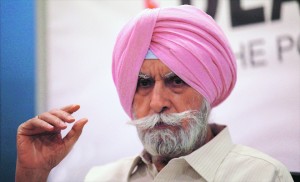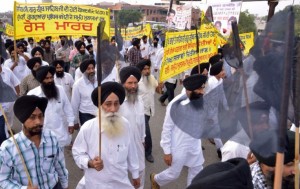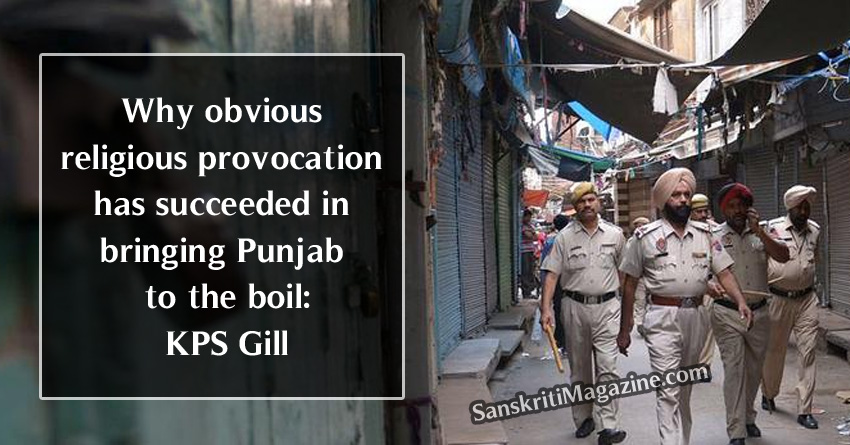An analysis of why cycles of violent protest in the state have been quickening over the past few years.
There is an enveloping atmosphere of political mischief across the country, an active effort to polarise communities for partisan political gains. This is deepened enormously by growing perceptions of the failure of governments to deliver on their promises, and efforts, on the one hand, by parties in power to distract attention from their own deficiencies and malfeasance, and on the other, by those who seek to destabilise the wider political and security situation, by orchestrating incidents that are intended to cause communal strife. This is particularly the case in Punjab, where the Akali Dal-Bharatiya Janata Party combine has been enormously discredited by years of non-performance and corruption.
 The sequence of events in the present desecration crisis in Punjab clearly demonstrates that these have been planned and coordinated. Seven such incidents have abruptly been conjured virtually out of the blue, in a situation that manifested no precedent indicators. There have, of course, been rare isolated incidents of alleged desecration of the Granth Sahib in the remote past, but these were explicable in terms of individual wrongdoing or specific local factors. There was nothing in the present manner, where the pages are intentionally torn out of the holy book and strewn in highly visible public places in obvious acts of provocation.
The sequence of events in the present desecration crisis in Punjab clearly demonstrates that these have been planned and coordinated. Seven such incidents have abruptly been conjured virtually out of the blue, in a situation that manifested no precedent indicators. There have, of course, been rare isolated incidents of alleged desecration of the Granth Sahib in the remote past, but these were explicable in terms of individual wrongdoing or specific local factors. There was nothing in the present manner, where the pages are intentionally torn out of the holy book and strewn in highly visible public places in obvious acts of provocation.
Significantly, it is to the credit of the Punjab Police that they have quickly solved most of the cases (five out of seven) and have publicised the conspiracy and its external links. Hard evidence of linkages between some of the perpetrators of the current desecration incidents, and elements in Dubai and Australia – most likely diaspora elements backed by Pakistan’s Inter Services Intelligence – have been shared with the media and public. Raucous, sometimes violent, demonstrations, nevertheless, continue across Punjab at the time of writing, organised by small groups who have traditionally been embroiled in the state’s often perverse gurudwara politics, but these will die down shortly.
Nevertheless, the current incidents demand deeper analysis.
Khalistan redux?
In the first place, this is because these incidents and the volatile response have again raised apprehensions in some quarters that the present disturbances could be a prelude to a Khalistani revival. Indeed, it can safely be assumed that this would have been the calculus – or certainly the hope – of those who have planned, funded and engineered these incidents. After the comprehensive defeat of Khalistani terrorism in 1993, there have been repeated attempts, at moments of some political tension within Punjab, to engineer incidents of violence or disruption in precisely the same expectation that these may catalyse a wider extremist resurgence.
Each of these past incidents failed, principally because their architects in the ISI and the alienated Sikh diaspora have misread the ground situation in Punjab. Extremist elements within the diaspora community remain trapped in the Khalistani mindset and constantly convince themselves through the fabrication of false histories that Punjab is teetering on the edge of another Khalistani upsurge. It would appear that ISI, which continues to host the tattered rump of the defeated Khalistani leadership on Pakistani soil, encourages – and possibly shares – such wild imaginings.
Any operation intended to provoke a widespread reaction needs to be based on a realistic assessment of the prevailing situation. The realities of the situation in Punjab, however, fail to reconcile with the constructs of those who seek to revive terrorism in the state. Indeed, Pakistan and radical elements within the Sikh diaspora have repeatedly miscalculated in the past, mistaking specific grievances as signs of a situation ripe for the resurgence of terrorism. This reflects their sheer ignorance, a misreading of the ground, and a proclivity to believe their own disinformation.
Abysmal state
 This does not, of course, mean that all is well in Punjab, and this is a second aspect of the current crisis that demands attention. Indeed, things are fairly abysmal in the state, and there is great dissatisfaction with governance, politics and endemic corruption. As a matter of fact, the state was in the middle of a widespread agitation by distressed farmers, when the desecration crisis abruptly shifted public attention from the enveloping and steadily worsening agricultural and rural catastrophe in Punjab – a calamity that is immeasurably worsened by the social consequences of rampant drug abuse and a drug trade in which, it is widely believed, the ruling elites are complicit.
This does not, of course, mean that all is well in Punjab, and this is a second aspect of the current crisis that demands attention. Indeed, things are fairly abysmal in the state, and there is great dissatisfaction with governance, politics and endemic corruption. As a matter of fact, the state was in the middle of a widespread agitation by distressed farmers, when the desecration crisis abruptly shifted public attention from the enveloping and steadily worsening agricultural and rural catastrophe in Punjab – a calamity that is immeasurably worsened by the social consequences of rampant drug abuse and a drug trade in which, it is widely believed, the ruling elites are complicit.
The combined impact of social, political and economic mismanagement – and endemic corruption – has been an accelerating collapse. It is useful, here, to recall that, when the Khalistani terrorism started, Punjab was ranked second among all states in India in terms of per capita income. More than 13 years of terrorism were not enough to destroy the enterprising spirit and the willingness to work, that are the hallmarks of Punjabi culture, and in 1993 – and, indeed, till the end 1990s – the state retained its position as the second-most prosperous in the country on per capita incomes. But what the most brutal terrorism could not achieve, a venal, incompetent and utterly unprincipled political elite have contrived. By 2013, Punjab was ranked 11th among Indian states on per capita incomes; by 2014, it had slid to the 14th position.
This, indeed, explains the quickening cycles of violent protest that have come to mar the Punjab over the past years over a range of minor and, occasionally, major issues. While the idea of Khalistan and terrorism find no traction whatsoever among the people, there is, nevertheless, tremendous latent frustration and anger, and the state comes quickly to the boil as soon as the inchoate public ire can find an emotive focus to fix on.
Religious manipulation
Finally, it is useful to reflect on the ease with which obvious and deliberate religious provocation succeeds in catalysing disruptive responses. The situation is reminiscent of devices used some decades ago, with almost certain outcomes, to provoke Hindu-Muslim rioting – throwing the dismembered parts of a cow or of a pig into a temple or a mosque, respectively. Over time, however, the larger population began to recognise the cynicism of this device, even as the police learned to handle such situations more effectively, bringing communities together, rather than going out with baton and bullet.
That such transparently obvious provocation – the planned and coordinated desecration of the Granth Sahib – in Punjab should have found significant resonance among some sections of Sikh society speaks poorly of the current state of the community. But this cannot surprise us. The core of politics in Punjab, and particularly of Sikh politics, has long been tainted by religious manipulation, with gurudwara politics – specifically, the politics of the immensely moneyed Shiromani Gurudwara Prabandhak Committee – playing a dominant role in the electoral dynamic. This has contributed to a growing fundamentalism among many Sikhs, and to an atmosphere of radicalisation and politicisation of the faith, within which acts of intentional provocation can secure such disproportionate and disruptive responses. This dynamic ordinarily recedes to the fringe when the Akalis are in power, but comes centre-stage whenever their power is threatened. In the present crisis, however, the Akalis have been pitted against the Sikh communalists, a constituency that they have long cultivated as their own.
It would appear that elements within the extremist fringe have broken away from their erstwhile Akali managers in an effort to directly seize the political initiative – something that had also occurred, albeit at a scale that bears no proportion to the present, during the years of terrorism.
~KPS Gill, Former Punjab Director General of Police, KPS Gill is President, Institute for Conflict Management and Publisher, South Asia Intelligence Review.











